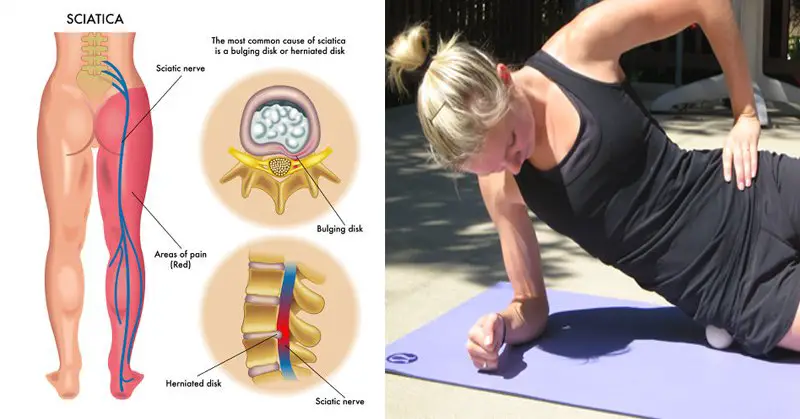Introduction
Can Weight Loss Help Sciatica: Sciatica is a painful condition that occurs when the sciatic nerve, which runs from the lower back down the back of each leg, becomes irritated or compressed. This condition can lead to debilitating pain, tingling sensations, and even muscle weakness in the affected leg. While sciatica is typically associated with issues like herniated discs or spinal stenosis, it’s important to consider how lifestyle factors, such as weight, may impact its development and severity. In this discussion, we will explore the relationship between weight loss and sciatica, investigating whether shedding excess pounds can offer relief from this excruciating condition and potentially improve overall quality of life.
Carrying excess weight places added pressure on the spinal column, particularly the lumbar region of the lower back. This additional strain can exacerbate conditions like herniated discs or spinal stenosis, both of which are common causes of sciatica. When the spine is overloaded, it can compress the sciatic nerve, intensifying the pain and discomfort associated with sciatica.
Obesity is often linked to chronic inflammation throughout the body. Inflammation can contribute to nerve irritation and compression, which are key factors in the development and persistence of sciatica symptoms. Reducing body fat through weight loss can help decrease inflammation and alleviate some of the pressure on the sciatic nerve. Achieving and maintaining a healthy weight can enhance blood circulation, delivering vital nutrients and oxygen to the affected areas. This improved circulation can promote healing and reduce the inflammation that contributes to sciatic pain.
Excess weight can strain the muscles in the lower back and legs, leading to weakness and decreased mobility. Weight loss can help strengthen these muscles and improve overall physical fitness, potentially reducing the risk of sciatica episodes and making it easier to manage the condition.

Will sciatica go away if I lose weight?
For our patients with ongoing or severe sciatica, we recommend physical therapy and epidural injections. Because weight places extra stress on your lumbar spine, losing weight not only eases your sciatica pain, but it also may prevent it from turning into a chronic pain condition.
Can Losing Weight Help Alleviate Sciatica
Reduced Pressure on the Spine: Losing weight can help reduce the pressure on the spinal column, potentially alleviating the compression of the sciatic nerve. This, in turn, can lead to a decrease in pain and discomfort.
Improved Inflammation Control: Weight loss can lead to a reduction in chronic inflammation, which may help calm down irritated nerves and alleviate sciatica symptoms.
Enhanced Mobility: As you shed excess pounds, you may experience improved mobility and increased physical activity. This can strengthen the muscles that support your spine and promote better posture, reducing the likelihood of sciatica recurrence.
Better Overall Health: Losing weight can improve your overall health and well-being, reducing the risk of other health conditions that can exacerbate sciatica, such as diabetes and cardiovascular disease.
It’s important to note that while weight loss can be beneficial for sciatica, it may not be a cure-all. Some cases of sciatica may be primarily caused by structural issues like herniated discs or spinal stenosis, which may require additional medical interventions, including physical therapy, medications, or even surgery.
Does being overweight contribute to sciatica?
Lots of factors can cause or contribute to sciatic nerve irritation and compression, including repetitive bending or lifting, back strain, or poor posture. Today, being overweight or obese is recognized as a common contributing factor to sciatica and its symptoms.
The Connection Between Weight and Sciatica
Increased Pressure on the Spine: Carrying excess weight, especially around the midsection, places additional pressure on the lumbar (lower) spine. This extra load can lead to compression or irritation of the sciatic nerve, as it passes through the lumbar region. The increased pressure on the nerve roots can result in the characteristic pain and discomfort associated with sciatica.
Spinal Disc Health: Obesity can have a detrimental effect on the health of the intervertebral discs that cushion the vertebrae in the spine. Excess weight can accelerate disc degeneration, and when these discs become damaged or herniated, they may impinge on the sciatic nerve, causing sciatica symptoms.
Inflammation: Obesity is often associated with chronic inflammation in the body. Inflammation can irritate nerves, including the sciatic nerve, and contribute to the development or persistence of sciatica.
Poor Posture and Muscle Weakness: People who are overweight or obese may be more prone to poor posture and muscle weakness. Weak core muscles and improper body mechanics can increase the risk of sciatica by putting added stress on the lower back and lumbar spine.
How much does weight affect sciatica?
Extra eight means extra pressure and pain
In fact, your joints and spine are subjected to four additional pounds of force for every extra pound of weight you carry. That means your sciatic nerve doesn’t stand a chance, and your nerve pain will be difficult to alleviate.
The Relationship Between Weight and Sciatica
Increased Pressure on the Spine: Excess body weight, particularly when concentrated around the abdominal area, can exert additional pressure on the lumbar (lower) spine. This added load can lead to compression or irritation of the sciatic nerve as it passes through the lumbar region. The increased pressure on the nerve roots can result in the characteristic pain and discomfort associated with sciatica.
Spinal Disc Health: Obesity can have a negative impact on the health of the intervertebral discs that cushion the vertebrae in the spine. Excess weight can accelerate disc degeneration, and when these discs become damaged or herniated, they may impinge on the sciatic nerve, causing sciatica symptoms.
Inflammation: Obesity is often associated with chronic inflammation throughout the body. Inflammation can irritate nerves, including the sciatic nerve, and contribute to the development or persistence of sciatica.
Poor Posture and Muscle Weakness: People who are overweight or obese may be more susceptible to poor posture and muscle weakness. Weak core muscles and improper body mechanics can increase the risk of sciatica by putting added stress on the lower back and lumbar spine
Do people fully recover from sciatica?
Most symptoms of sciatica will improve with time. Nerves are resilient and in most cases inflammation and any disc changes resolve allowing nerves to recover.
Recovery from Sciatica
Underlying Cause: The cause of sciatica plays a significant role in determining the potential for recovery. Sciatica can result from various factors, including herniated discs, spinal stenosis, muscle imbalances, or even excess body weight. Some causes are more easily treatable than others.
Severity of Symptoms: The severity of sciatica symptoms can range from mild discomfort to debilitating pain. Individuals with milder symptoms often have a better chance of full recovery than those with severe and long-lasting pain. Early diagnosis and treatment can be crucial in achieving a favorable outcome.
Treatment Approach: The choice of treatment can significantly impact recovery. Conservative treatments such as physical therapy, pain medication, and lifestyle modifications are often the first line of defense against sciatica. In many cases, these treatments can lead to substantial improvement and eventual recovery. However, some cases may require more invasive interventions like epidural injections or surgery.
Individual Response: How an individual responds to treatment can vary. Some people may experience rapid relief and a full recovery with conservative measures, while others may require a more extended period of treatment and symptom management.
Chronic Sciatica: In some instances, sciatica can become chronic, with persistent or recurring symptoms. Chronic sciatica may require ongoing management and a combination of treatments to maintain a reasonable quality of life.
Will sciatica go away without exercise?
Even though the pain and numbness in your leg may make you want to spend some time resting or even take to your bed, that won’t improve your symptoms. In fact, too much rest could even make them worse.
The Natural Course of Sciatica
Underlying Cause: The cause of sciatica plays a significant role in its natural course. Sciatica can result from various factors, including herniated discs, spinal stenosis, muscle imbalances, or even excess body weight. Some causes may improve on their own over time, while others may require specific treatment.
Severity of Symptoms: The severity of sciatica symptoms can range from mild discomfort to debilitating pain. Milder cases of sciatica may have a better chance of resolving without intervention, while severe cases are less likely to go away on their own.
Patient Factors: Individual factors, such as age, overall health, and the body’s ability to heal, can influence the natural course of sciatica. Younger, healthier individuals may recover more quickly than older individuals with underlying health issues.
Activity Level: While exercise is not always required for sciatica resolution, remaining active and maintaining good posture can help alleviate symptoms and prevent them from worsening. Staying sedentary and engaging in activities that worsen symptoms may slow down the recovery process.
Time: Sciatica can be acute (short-term) or chronic (long-term). Acute cases often resolve on their own within a few weeks to a few months. Chronic sciatica may persist for longer periods and may require more active intervention.
Can you live normally with sciatica?
Summary. Sciatica can be intensely painful, although most people do not have to live with it long term. It is common for sciatica to last for several weeks. If weeks turn into months, however, this may indicate that it is time to seek a diagnosis and explore other treatment options.
Strategies for Living Normally with Sciatica
Pain Management: Effective pain management is crucial. Over-the-counter pain relievers, prescription medications, and non-pharmacological approaches like heat or ice therapy can help alleviate discomfort.
Physical Therapy: Engaging in physical therapy exercises designed to strengthen core muscles, improve flexibility, and promote proper posture can significantly reduce sciatica symptoms and enhance mobility.
Lifestyle Modifications: Making adjustments to daily activities can reduce the strain on the sciatic nerve. These may include avoiding prolonged sitting, using ergonomic furniture, and maintaining a healthy weight.
Exercise: While it may seem counterintuitive, staying active with the guidance of a healthcare professional is essential. Low-impact exercises like walking, swimming, or yoga can help manage symptoms and improve overall well-being.
Diet and Weight Management: Maintaining a healthy diet and weight can reduce the pressure on the spine, which can be particularly beneficial for individuals whose excess weight contributes to their sciatica.
Psychological Support: Chronic pain conditions like sciatica can take a toll on mental health. Seeking psychological support, such as counseling or mindfulness-based therapies, can help individuals cope with pain and stress.
Should I limit walking with sciatica?
While walking may help a person manage sciatica, it is important not to do activities that may worsen the pain. A doctor may recommend a person take shorter walks. A person may wish to gradually build up the length of time they walk. Taking breaks when they feel they need to is also important.
Guidelines for Walking with Sciatica
Consult Your Healthcare Provider: Before starting or modifying any exercise routine, consult your healthcare provider or a physical therapist. They can provide personalized recommendations based on your specific condition and needs.
Start Slowly: If you are not accustomed to regular walking, begin with short walks at a slow pace. Gradually increase the duration and intensity as your tolerance improves.
Listen to Your Body: Pay close attention to how your body responds to walking. If you experience increased pain or discomfort during or after walking, it’s essential to adjust your routine accordingly.
Choose Proper Footwear: Wear comfortable, supportive shoes with good arch support to minimize the risk of exacerbating sciatica symptoms.
Maintain Good Posture: Focus on maintaining good posture while walking. Keep your back straight, shoulders relaxed, and head aligned with your spine. Avoid hunching forward or leaning to one side.
Warm Up and Cool Down: Prior to walking, perform gentle warm-up exercises and stretches to prepare your muscles and joints. Afterward, engage in cool-down stretches to prevent stiffness.
Terrain Matters: Choose flat and even terrain for walking, as uneven surfaces can increase the risk of falls and exacerbate sciatica symptoms.
Can walking too much hurt sciatica?
A walking routine might help your sciatica, but can walking make sciatica pain worse instead? It’s possible. Your sciatica pain getting worse while performing an activity is a clear indicator that you should back off from that particular activity, and walking is no exception.
Potential Risks of Excessive Walking for Sciatica
Overexertion: Excessive walking without proper conditioning or warm-up can lead to overexertion, which may exacerbate sciatica symptoms. It’s important to gradually increase the duration and intensity of walking to avoid overuse injuries.
Inadequate Rest: Failing to allow sufficient rest between walking sessions can lead to fatigue and muscle strain, potentially worsening sciatica-related discomfort.
Poor Posture: Walking with poor posture, such as hunching forward or leaning to one side, can place additional stress on the spine and aggravate sciatica symptoms.
Terrain Issues: Walking on uneven or challenging terrain, such as steep hills or rough trails, can increase the risk of falling or injuring yourself, which can indirectly affect sciatica.
Ignoring Pain Signals: Pushing through pain during walking can worsen sciatica symptoms. It’s essential to listen to your body and adjust your walking routine if you experience increased pain or discomfort.
Inappropriate Footwear: Wearing unsupportive or ill-fitting shoes can lead to improper gait and posture, potentially worsening sciatica-related issues.

Conclusion
In the pursuit of relief from the debilitating pain and discomfort associated with sciatica, the role of weight loss emerges as a significant factor. While weight loss may not serve as a standalone cure for this condition, its impact on alleviating symptoms and improving overall well-being cannot be overlooked. Excess weight places undue strain on the spine, contributing to the compression of the sciatic nerve and exacerbating the underlying causes of sciatica, such as herniated discs or spinal stenosis. Weight loss can reduce this pressure, leading to decreased inflammation and irritation of the nerve. It also promotes improved blood circulation, strengthening of key muscles, and increased mobility, all of which contribute to better management of sciatica.
However, it’s essential to emphasize that weight loss should be pursued in a safe and gradual manner under the guidance of healthcare professionals. Rapid or extreme weight loss methods can have adverse effects and are unlikely to provide sustainable relief.
In the comprehensive treatment sciatica, weight loss is just one piece of the puzzle. It should be combined with other strategies such as physical therapy, medication, and lifestyle adjustments. An individualized approach, tailored to the specific causes and symptoms of each patient, is crucial.

